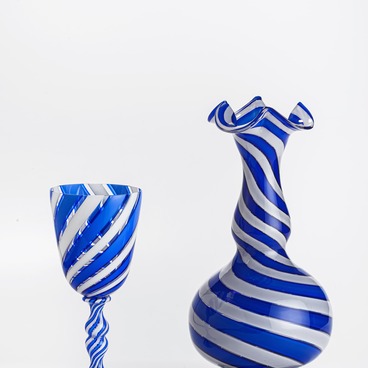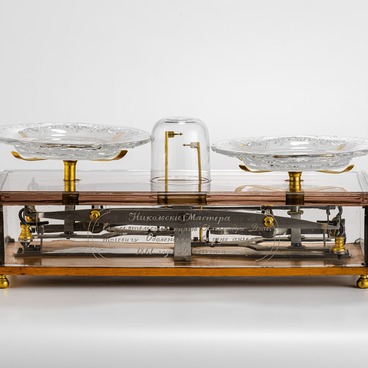In the late 19th — early 20th century, multi-tier stands with glass bowls became popular among wealthy people. The stand occupied little space on the table and at the same time it was possible to serve a large number of various treats.
Initially, the large bottom dish of the stand was intended for candied fruits, the middle one — for petit fours, and “confections” were placed on the top small one; fruit could also be served in this way.
Long before the 19th century, such stands became one of the symbols of the high culture of eating in Italy. At that time bowls made of colored or colorless crystal were framed with bronze or silver and decorated with miniature figurines. Variants of such vases had existed in Russia even before glass began to be commonly used. Sweets, marinades and candied fruits were put in metal tiered bowls.
In factory price lists, such products are called “vases with removable plates.” One of the first glass stands from the Nikolsko-Bakhmetevsky factory consisted of one bowl and a “bouquet holder”, that is, a small vase for flowers. Later, in the 1970s and 1980s, the “Red Giant” factory launched the production of two- and three-tier stands. Elegantly decorated crystal bowls were fastened to a cupronickel rack, which was crowned with a ring of the same material or a bouquet holder. The bowls were connected to the rack when they were cold.
The vase from the museum’s collection was designed by Pyotr Ledyaev, who worked at the experimental art workshop of the glass factory. Jagged petals are carved along the edges of all crystal objects. Each bowl is decorated with five large leaves. The double contour of the leaves is decorated with a cut gossamer pattern. Between the leaves, the craftsman depicted large blunt four- and sixteen-sided figures. The bouquet holder is decorated with three leaves along one edge. A round mount serves as a support for the cupronickel rod.
The technique of deep cutting was used to create the stand. Patterns are applied using a special cutter. After carving, the edges are carefully polished to give the product a “diamond shine” and a distinct sparkle. The technique makes it possible to create both simple geometric patterns of straight lines, rhombuses, and polygons, and figures with curved lines.
Initially, the large bottom dish of the stand was intended for candied fruits, the middle one — for petit fours, and “confections” were placed on the top small one; fruit could also be served in this way.
Long before the 19th century, such stands became one of the symbols of the high culture of eating in Italy. At that time bowls made of colored or colorless crystal were framed with bronze or silver and decorated with miniature figurines. Variants of such vases had existed in Russia even before glass began to be commonly used. Sweets, marinades and candied fruits were put in metal tiered bowls.
In factory price lists, such products are called “vases with removable plates.” One of the first glass stands from the Nikolsko-Bakhmetevsky factory consisted of one bowl and a “bouquet holder”, that is, a small vase for flowers. Later, in the 1970s and 1980s, the “Red Giant” factory launched the production of two- and three-tier stands. Elegantly decorated crystal bowls were fastened to a cupronickel rack, which was crowned with a ring of the same material or a bouquet holder. The bowls were connected to the rack when they were cold.
The vase from the museum’s collection was designed by Pyotr Ledyaev, who worked at the experimental art workshop of the glass factory. Jagged petals are carved along the edges of all crystal objects. Each bowl is decorated with five large leaves. The double contour of the leaves is decorated with a cut gossamer pattern. Between the leaves, the craftsman depicted large blunt four- and sixteen-sided figures. The bouquet holder is decorated with three leaves along one edge. A round mount serves as a support for the cupronickel rod.
The technique of deep cutting was used to create the stand. Patterns are applied using a special cutter. After carving, the edges are carefully polished to give the product a “diamond shine” and a distinct sparkle. The technique makes it possible to create both simple geometric patterns of straight lines, rhombuses, and polygons, and figures with curved lines.




